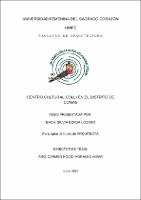Centro Cultural Colli en el distrito de Comas
Abstract
El problema abordado en el presente trabajo de investigación se enfoca en el ámbito del desarrollo cultural local, y como resultado del mismo, tata de asegurar el acceso y participación de la ciudadanía en el quehacer artístico y cultural de su tiempo, y sabemos que ello no es posible sin la existencia de espacios físicos donde se creen, exhiban y circulen bienes culturales en su calidad de público y/o creadores; donde también sea posible acceder a formación y capacitación en artes, y se desenvuelvan libremente el intercambio y el debate en torno a la cultura y sus modos de expresión particulares. En cuanto a la proyección arquitectónica del espacio cultural, se toma como partido de diseño la permeabilidad, como estrategia para establecer y lograr la interacción controlada entre la edificación y el espacio público, animando al encuentro, la convivencia e integración social. Esta investigación se define como: aplicada, por estar basada en conocimientos pre-existentes acerca de la relación entre la arquitectura, cultura y sociedad, con el fin de proponer una fórmula para reflexionar, mejorar y fortalecer los sistemas de formación cultural local y a partir de aquí, contribuir al desarrollo de la dinámica cultural, propia del distrito de Comas. En resumen, se trata de un primer paso en el largo y complejo proceso hacia la obtención, implementación y evaluación de un proyecto que resuelve necesidades de ámbito local para la orientación y gestión de políticas culturales, dentro de un contexto denominado como el distrito de Lima-Norte. The problem lectured in this investigation, focuses on the field of local cultural development, and as a result, try to ensure access and participation of citizens in the artistic and cultural activities of their time, and we know that this is not possible without the existence of physical spaces where they think, exhibit and circulate cultural goods as a public and / or creators; where it also possible to access education and training in the arts, and unfold freely exchange and debate about culture and ways of individual expression. As for the architectural design of cultural space, it is taken as a principal concept design the “permeability”, as a strategy to set and achieve the controlled interaction between the building and the public space, encouraging the meeting, coexistence and social integration. This research is defined as applied, being based on pre-existing knowledge about the relationship between architecture, culture and society, in order to propose a formula to reflect, improve and strengthen system of local cultural training and from hence, contribute to the development of own cultural dynamics of the district of Comas. In summary, this is first step in the long and complex process towards obtaining, implementation and evaluation of a project that meets local needs for guidance and management of cultural politics, within a context referred to as the cultural district of the northern region of Lima City.
Description
Tesis
Collections
- Arquitecta [114]
The following license files are associated with this item:


